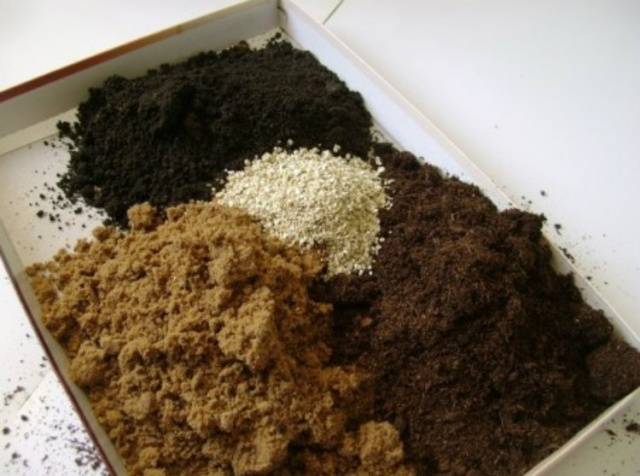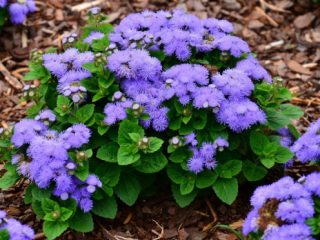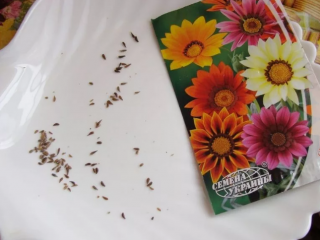Content
Ageratum Blue Mink is an ornamental herbaceous plant in the form of a low bush with soft blue flowers very similar to the color of the skin of a young mink. The shape of the flowers also resembles the fur of this animal with its soft, hairy petals. The photo shows a typical representative of this ageratum variety. In our article we will talk in detail about how to grow this flower from seeds.
From seed to flower
The progenitors of ageratum come from southern countries, love warmth and light, a moderately humid climate, tolerate short periods of drought well and are very sensitive to the composition of the soil. Heavy and loamy soils or shaded, windy areas are not for them. You can get abundantly flowering and healthy plants only by taking these nuances into account.
Description
Ageratum Blue Mink belongs to the Asteraceae family, it is cultivated in an annual form, the main indicators of varietal affiliation are:
- ageratum root - a strongly growing rhizome, superficial, buried in the ground no more than 20 cm;
- stems are erect, covered with sparse hairs;
- leaves are light green, oval, compressed with jagged edges, small near the inflorescence, larger closer to the root part, growing densely;
- on the racemes of ageratum, many peduncles are formed, collected in a cluster similar to a fluffy ball;
- flowers - many tubercles are formed on the flat core, from which thin petals of a delicate blue hue, fragrant, up to 3 cm in diameter grow;
- Ageratum fruits are a seed capsule that contains many very small seeds;
- the height of the bushes varies from 30 to 70 cm, this depends on many conditions: the quality of the seeds, weather conditions, compliance with agricultural technologies;
- flowering time - for the Blue Mink ageratum they are very long, the blooming of flowers begins 2 months after planting the seedlings in the ground, and ends in October;
- Ageratum seeds are extremely small, sometimes it is difficult to sow them in containers or open ground so that they are distributed evenly over the surface.
In the video at the end of the page, an experienced gardener explains how this can be done in practice. Here you will see all the stages of growing Blue Mink agetarum from seeds.
Seed preparation
The annual plant Ageratum Blue Mink is grown only from seeds, they can be purchased on the open market, there will be no complications with this. Difficulties may arise when sowing them, since the seeds of ageratums are microscopic.
Flower growers sow ageratum in two ways: with preliminary soaking and further picking or dry seeds. Without soaking, that is, in the classical way, you need to sow them directly into a moistened substrate.
Soaking small seeds will allow you to determine at an early stage whether the ageratum seeds are suitable for subsequent planting in the ground. Poor quality, that is, ungerminated seeds, are removed after 3-7 days; they should not take up space in seedling containers.
Preparing the substrate
Ageratum Blue mink requires loose and light soil; on heavy soil this plant develops poorly, the roots become sick, and flower ovaries do not form. The earthen mixture can be purchased at special stores for gardeners or prepared independently. The soil mixture should consist of the following components:
- Fertile soil (chernozem or ordinary garden soil) - 1 part.
- Coarse river sand or other leavening agent (fine sawdust, ash) - 1 part.
- Leaf humus or high peat - 1 part.
All components are thoroughly mixed and disinfected using thermal or chemical methods. The hot method is frying the substrate in an oven or over a fire directly in the garden. The chemical method involves treating the mixture with preparations designed specifically for these purposes. They are commercially available, find out the instructions for use and dosage by reading the attached recommendations.
The substrate must be checked for soil acidity (this also applies to open ground); Ageratum Blue Mink prefers neutral or slightly alkaline substances. Strips of paper coated with litmus will help determine the acidity of the soil. These days, every gardener has some in stock; borrow from a neighbor or buy them at the store.
Sowing
Blue Mink ageratum begins to be sown as early as January or February. The growing season of ageratums of all varieties is long, at least 100 days must pass from sowing to the first flowers, therefore, the sooner the seeds are sown, the sooner flower ovaries are formed.The sowing technology is as follows:
- pour dry ageratum seeds into containers with prepared soil (necessarily damp), before this you can mix them with sand for ease of sowing; if the seeds are already germinated, carefully distribute them on the surface;
- Sprinkle the entire surface with the sown seeds with a thin (1 cm) layer of the same substrate and press lightly with your palm;
- Water moderately, trying not to move the seeds;
- Cover the container with a paper towel to collect condensation, and cover it with a lid or glass;
- the container should be placed in a warm place, since ageratums are heat-loving and will begin to grow at a temperature not lower than +25° C;
- Within a week, the first sprouts of ageratum with cotyledon leaves should appear.
After 7-8 days, the first fertilizing of the seedlings is carried out, combining it with watering. It is not recommended to feed the plant abundantly. To start, use a little powder to stimulate growth. Nitrogen fertilizers are not recommended at this stage of the ageratum growing season.
Seedling care
Before the time comes to transplant ageratum seedlings into open ground, a greenhouse or a greenhouse, you will need to constantly care for the young shoots:
- regularly water with warm water heated to 25 degrees;
- maintain indoor air humidity and temperature;
- remove wilted leaves of ageratum;
- add lighting if the days are cloudy;
- feed ageratums 1-2 times a month;
- 2-3 weeks, or better yet a month, before planting ageratums in open ground, hardening is carried out: starting from 30 minutes and gradually increasing the time, take the containers with seedlings out into the open air.
Compliance with the rules of care ensures that young ageratums grow strong and healthy, ready for planting in the ground in a permanent place.
Landing in the ground
In the top photo we see that not all seeds have grown evenly. Do not rush to draw conclusions and throw away weak plants, many of them will still gain strength and catch up with their relatives. If the time has come to transplant the seedlings into the ground, proceed as follows:
- select the tallest and healthiest ageratum sprouts with 3-4 true leaves and plant them in the ground at a distance of 15-20 cm from each other (see video);
- leave small, stunted seedlings in a container, water them with a solution that stimulates plant growth, and add a little nitrogen fertilizer;
- this method effectively affects most of the seedlings, the sprouts will actively begin to grow and quickly form new leaves;
- after 10 days, all ageratum seedlings will “migrate” to fresh air; very weak shoots can be transplanted into separate pots and grown as indoor flowers.
Open areas
The area for planting Ageratum Blue Mink should be well lit by the sun and not blown by frequent winds. On the leeward side you can plant tall perennials that will perform a windproof function. The soil in flower beds and beds is preferred to be light and fertilized. Ageratums do not tolerate loams and acidified soils. Ageratum seedlings are planted in May or June; the timing directly depends on climatic conditions.
- Plants are carefully separated from each other, protecting roots and leaves from breakage.
- Planted in shallow holes with a lump of earth at a distance of 25 cm.
- Water moderately.
The entire process is shown in more detail in the video posted at the end of the article.Watch it to the end and you won't regret your time.
Greenhouses
In closed heated greenhouses, they are grown mainly for sale, only Blue Mink ageratum seedlings. This happens in January-February. The conditions of the greenhouse make it possible to obtain seedlings at the very beginning of the spring-summer season, when gardeners begin the sowing campaign in their summer cottages. Seedlings of different varieties of ageratum are grown here, the most popular of which are: Blue Mink, White Ball, Pink Elephant and others. The sale of ready-made ageratum seedlings frees flower growers from the work associated with growing seedlings. There are situations when flower lovers simply do not have the opportunity to do this: there is no space, no time, or there are some contraindications.
Seedling care
Our ageratum variety is unpretentious in care, as it is demanding of soil and light, but gardeners should not leave this plant without attention. The most minimal care contributes to the successful development of the crop, abundant flowering and the growth of bright green foliage. Ageratum bushes quickly and actively grow green mass, closing the living space for the germination of weeds, so even weeding is not required.
Application in design
Ageratum Blue Mink is used to decorate gardens, parks, and city alleys. Its delicately colored flowers harmonize with many plants in floral arrangements. The compactness and low growth of the bushes allows city residents to grow it on their loggias and balconies. Landscape designers complement the design of picturesque flower beds with this small, delicate and fragrant plant.













